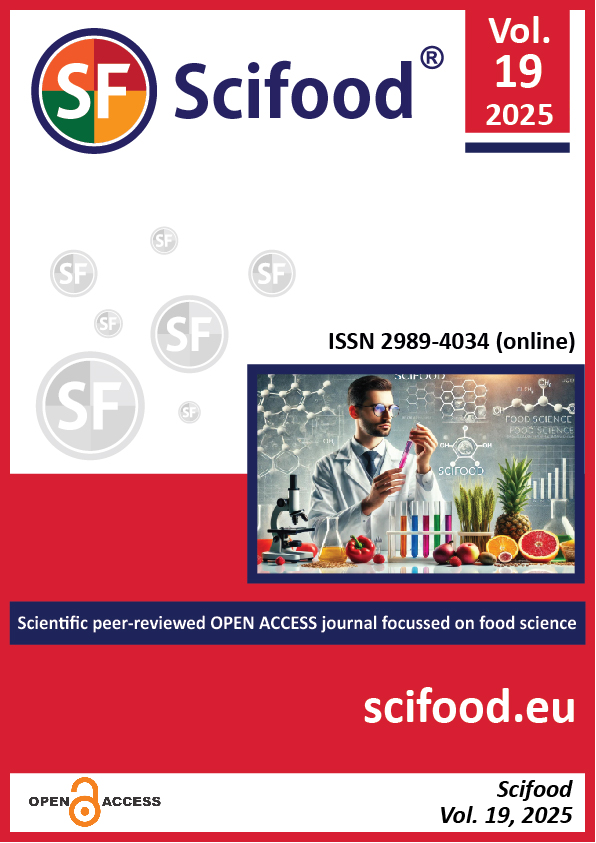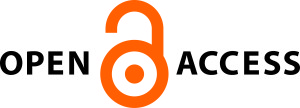A cellular dynamic mathematical model of a conveyor dryer as an object of automatic control
DOI:
https://doi.org/10.5219/scifood.13Keywords:
conveyor dryer, identification, cellular mathematical model, drying rate, drying agent, moisture contentAbstract
In the paper, based on the analysis of the technological process of fruit drying in a conveyor-type dryer, the major regime parameters, control effects of the object, control variables and disturbing factors are determined. Considering the equations of the kinetics of heat and mass transfer of the dried product, control diagrams, certain standard assumptions and initial conditions, a system of ordinary differential equations for the convective drying of fruit in a conveyor-type dryer has been developed. In the system of equations of heat and mass transfer of the process, the drying coefficient in the first and second periods and the heat transfer coefficient were determined due to identification. The solution of the problem of determining the above parameters is reduced to solving the problem of minimising the criterion for assessing the degree of the mean square deviation of the difference between the solutions of the system of experimental and heat-mass transfer differential equations of the plum drying process. During the drying of blue plums, we have obtained the following values of unknown parameters: drying rate coefficient in the first period – K1=0.8309∙10-4 kg∙(m2∙s∙oC)-1; drying rate coefficient in the second period–K2=0.3413∙10-4 kg∙(m2∙s∙oC)-1 and heat transfer coefficients: α2∙ϕ2=0.0794 kW∙(kg∙oC)-1, α3∙F3=0.0245 kW∙(kg∙oC)-1 and critical moisture content of blue plums wCR=71%. The energy reduction spent on the drying process is 4%. The “cellular” dynamic characteristics of the relative humidity and temperature of the drying agent during blue plum drying, obtained as a result of the experimental and theoretical study of the conveyor drying unit, allow us to judge the 96% - 98% adequacy of the developed dynamic mathematical model. The research found that the dynamic characteristics of the residual moisture content of blue plums at the dryer outlet were 11%.
References
1. Bakhshipour, A., Zareiforoush, H. & Bagheri, I. (2020). Mathematical and intelligent modeling of stevia (Stevia Rebaudiana) leaves drying in an infrared-assisted continuous hybrid solar dryer. In Journal Food Science and Nutrition, Online First. (Vol. 9, No. 1, pp. 532-543). Wiley https://doi.org/10.1002/fsn3.2022
2. Kiurchev, S., Verkholantseva, V., Kiurcheva, L., & Dumanskyi, O. (2020). Physical-mathematical modeling of vibrating conveyor drying process of soybeans. In Engineering for Rural Development. 19th International Scientific Conference Engineering for Rural Development. Latvia University of Life Sciences and Technologies, Faculty of Engineering. https://doi.org/10.22616/erdev.2020.19.tf234
3. Moses, J. A., Norton, T., Alagusundaram, K., & Tiwari, B. K. (2014). Novel Drying Techniques for the Food Industry. In Food Engineering Reviews (Vol. 6, Issue 3, pp. 43–55). Springer Science and Business Media LLC. https://doi.org/10.1007/s12393-014-9078-7
4. Wutisart, Th. (2022). Development of automatic control system for solar drying cabinet. Suan Sunandha Science and Technology Journal (Vol. 9, No.1, pp. 1-4). https://doi.org/10.14456/SSSTJ.2022.1
5. Friso, D. (2021). Conveyor-Belt Dryers with Tangential Flow for Food Drying: Development of Drying ODEs Useful to Design and Process Adjustment. Inventions (Vol. 6, Issue 1, 6 p). https://doi.org/10.3390 /inventions6010006
6. Aleksanyan, I. Yu., Maksimenko, Yu. A., Nugmanov, A. Kh., & Nguyen, T. S. (2020). Study of kinetic patterns and modeling of heat and mass transfer in the process of jackfruit drying. In Storage and processing of agricultural raw materials, (Issue 1, pp. 8–22). Moscow State University of Food Production. https://doi.org/10.36107/spfp.2020.212
7. Abdulla, Sh., Wen, P., Landers, R., & Yousi, B. F. (2011). Fruit drying process: Analysis, modeling and simulation. In Scientific Research and Essays, (Vol. 6, No. 23, pp. 4915-4924). https://doi.org/10.5897/SRE11.121
8. Borhade, Y.V., Siddesh, P., Akshay, S., Pranav, J., & Rutik, P. (2022). Solar Powered Automatic Fruit Drying Syatem. In International Journal of Advanced Research in Science, Communication and Technology (Vol. 2, Issue 2, pp. 335-341). Naksh Solutions, https://doi.org/10.48175/568
9. Pavlushin, A., Sutyagin, S., Karpenko, G., & Artemiev, V. (2020). Research of a machine with a belt conveyor for drying grain. In S. Bratan (Ed.), E3S Web of Conferences (Vol. 193, p. 01071). EDP Sciences. https://doi.org/10.1051/e3sconf/202019301071
10. International Organization for Standardization. (2001). Green coffee – Determination of the moisture content – Basic reference method—Requirements with guidance for use (ISO Standard No. 1446:2001). Available at: https://www.iso.org/standard/34008.html
11. Ostrikov, A. N., Ospanov, A. A., Shevtsov, A. А., Muslimov, N. Zh., Timurbekova, A. K., & Jumabekova, G. B. (2020). Mathematical model of high-temperature tube-shaped pasta drying in a conveyer belt drier. In International Journal of Food Engineering (Vol. 17, Issue 3, pp. 209–215). Walter de Gruyter GmbH. https://doi.org/10.1515/ijfe-2020-0101
12. El-Mesery, H. S., Ashiagbor, K., Hu, Z., & Rostom, M. (2024). Mathematical modeling of thin-layer drying kinetics and moisture diffusivity study of apple slices using infrared conveyor-belt dryer. In Journal of Food Science (Vol. 89, Issue3, pp. 1658-1671). Wiley. https://doi.org/10.1111/1750-3841.16967
13. García-Moreira, D. P., Hernández-Guzmán, H., Pacheco, N., Cuevas-Bernardino, J.C., Herrera-Pool, E., Moreno, I., & López-Vidaña, E.C. (2023). Solar and Convective Drying: Modeling, Color, Texture, Total Phenolic Content, and Antioxidant Activity of Peach (Prunus persica (L.) Batsch) Slices. In Processes (Vol. 11, Issue 4, 1280). MDPI AG. https://doi.org/10.3390/pr11041280
14. Friso, D. (2020). Conveyor-Belt Dryers with Tangential Flow for Food Drying: Mathematical Modeling and Design Guidelines for Final Moisture Content Higher Than the Critical Value. In Inventions (Vol. 5, Issue 2, p. 22) MDPI AG. https://doi.org/10.3390/inventions5020022
15. Friso, D. (2021). Mathematical Modelling of Conveyor-Belt Dryers with Tangential Flow for Food Drying up to Final Moisture Content below the Critical Value. In Inventions (Vol. 6, Issue 2, p. 43). MDPI AG. https://doi.org/10.3390/inventions6020043
16. Druzhinina, O. N., Masina, E. V., Igonina, E. V. & Petrov, A. A. (2021). Synthesis and computer research of a belt conveyor models with intelligent control. Workshop on information technology and scientific computing in the framework of the XI International Conference Information and Telecommunication Technologies and Mathematical Modeling of High-Tech Systems (Moscow, April 19-23, pp. 6 - 16). Available at: https://ceur-ws.org/Vol-2946/paper-01.pdf
17. Bottaria, A., & Bracciab, L. (2023). Optimal Control Structure Selection Based on Economics for Continuous Cross-Flow Grain Dryer. In Drying Technology, An International Journal (Vol. 41, Issue 10. pp. 1605-1619). Informa UK Limited. https://doi.org/10.1080/07373937.2023.2167829
18. Ramachandran, R. P., Akbarzadeh, M., Paliwal, J., & Cenkowski, S. (2017). Computational Fluid Dynamics in Drying Process Modelling - A Technical Review. In Food and Bioprocess Technology (Vol. 11, pp. 271-292). Springer Science and Business Media LLC. https://doi.org/10.1007/s11947-017-2040-y
19. Bagheri, N., Keyhani, A., Mohtasebi, S. S., Alimardani, R., Rafiee, Sh., & Mansoori, G. H. (2013). Design, Construction and Evaluation of a Fan Speed Controller in a Forced Convection Solar Dryer to Optimize the Overall Energy Efficiency. In Journal of Agreculture Science Technology (Vol. 13, pp. 503-515). DOR: 20.1001.1.16807073.2011.13.4.12.1
20. Mutumba, R., Kigozi, J., Tumutegyereize, P., Ssenyimba, S., & Muyonga, J. (2021). Arduino based control of the Food and Water Conveyance Systems of a Refractance Window Dryer. In International Journal Of Scientific Advances (Vol. 2, Issue 5). International Journal of Scientific Advances. https://doi.org/10.51542/ijscia.v2i5.25
21. Abdussamad, J., & Salisu, U. (2015). Microcontroller-based fruit drying system. In Atbu journal of science. Technologasedy and education (joste) (Vol. 3, No. 3, pp. 102-110).
22. Atykhanov, A., & Kassymbayev. B. (2015). A fruit drying mathematical model. In International Journal of Pure and Applied Mathematics (Vol.101, No.2, pp. 281-288). Academic Publications, LTD. https://doi.org/10.12732/ijpam.v101i2.12
23. Reppich, M., Jegla, Z., Grondinger, J., Azouma, Y. O., & Turek, V. (2021). Mathematical Modeling of Drying Processes of Selected Fruits and Vegetables. In Chemie Ingenieur Technik (Vol. 93, Issue 10, pp. 1581-1589 Wiley. https://doi.org/10.1002/cite.202100029
24. Akter, F., Muhury, R., Sultana, A., & Deb, U. K. (2022). A Comprehensive Review of Mathematical Modeling for Drying Processes of Fruits and Vegetables. In E. Hernández (Ed.), International Journal of Food Science (Vol. 2022, pp. 1–10). Hindawi Limited. https://doi.org/10.1155/2022/6195257
25. Golestani, R., Raisi, A., & Aroujalian, A. (2013). Mathematical Modeling on Air Drying of Apples Considering Shrinkage and Variable Diffusion Coefficient. In Drying Technology An International Journal (Vol. 31, Issue 1, pp. 40–51). Informa UK Limited. https://doi.org/10.1080/07373937.2012.714826
26. Yue, Y., Zhang, Q., Wan, F., Ma, G., Zang, Z., Xu, Y., Jiang, C., & Huang, X. (2023). Effects of Different Drying Methods on the Drying Characteristics and Quality of Codonopsis pilosulae Slices. In Foods (Vol. 12, Issue 6, p. 1323). MDPI AG. https://doi.org/10.3390/foods12061323
27. Polat, A., & Izli, N. (2022). Drying of garlic slices by electrohydrodynamic‐hot air method. In Journal of Food Process Engineering (Vol. 45, Issue 3). Wiley. https://doi.org/10.1111/jfpe.13980
28. Bardavelidze, A., & Bardavelidze, K. (2024). Development and investigation of algorithm for the synthesis of an automatic control system of the drying process. In International Journal on Information Technologies and Security (Vol. 16, Issue 1, pp. 15–26). International Journal on Information Technologies and Security. https://doi.org/10.59035/ojbv6115
29. Bardavelidze A., Bardavelidze Kh., & Sesikashvili, O. (2024). Development and study of a multi-criteria optimal control algorithm for the static mode of the fruit tunnel dehydration process. Journal of Food and Nutrition Research (Vol. 63, No. 1, pp. 69-78). National Agricultural and Food Centre (Slovakia).
30. Bardavelidze, A., Bardavelidze, Kh., & Sesikashvili, O. (2023). Mathematical model of the static mode of tunnel dehydrator for fruits as a controlled object. Journal of Food and Nutrition Research (Vol. 62, No. 4, pp. 305-313) National Agricultural and Food Centre (Slovakia).
31. Tarasenko, T., Yevlash, V., Nyemirich, O., Vasheka, O., Gavrish, A., & Kravchenko, O. (2015). Theoretical studies drying ways fruits and vegetables. In Scientific Messenger of LNU of Veterinary Medicine and Biotechnologies. Series Food Technologies, (Vol.17, No.4 (64), pp. 148-157). National University of Veterinary Medicine and Biotechnologies Lviv.
32. Strashinin, E. E., Zakolyapin, A. D., Trofimov, S. P., & Yurlova, A. A. (2019). Theory of automatic control. Textbook, Russian Federation, Yekaterinburg, 456 p. ISBN 978-5-7996-2788-1
33. Popov, V. P., & Gruzintseva, V. A. (2008). Design of the technological process of drying of cardboard products. Orenburg, 141 p. ISBN 4001040000
34. Yang, T., Zheng, X., Xiao, H., Shan, C., Yao, X., Li, Y., & Zhang, J. (2023). Drying Temperature
Precision Control System Based on Improved Neural Network PID Controller and Variable-Temperature Drying Experiment of Cantaloupe Slices. In Plants (Vol. 12, Issue 12, p. 2257). MDPI AG. https://doi.org/10.3390/plants12122257
35. Pinheiro, M. N. C., Madaleno, R. O., & Castro, L. M. M. N. (2022). Drying kinetics of two fruits Portuguese cultivars (Bravo de Esmolfe apple and Madeira banana): An experimental study. In Heliyon (Vol. 8, Issue 4, p. e09341). Elsevier BV. https://doi.org/10.1016/j.heliyon.2022.e09341
36. Spirin, N.A., Lavrov, V.V., Zainullin, L.A., Bondin, A.R., & Burykin, A.A. (2015). Methods of planning and processing the results of an engineering experiment: A tutorial. Edited by N.A. Spirin. Ekaterinburg: OOO "UI","UINC", 290 p. ISBN 978-5-9904848-4-99
37. Dzerzhinsky, R., Pronina, E., & Jinchvelashvili, G. (2021). Applied Optimal Control Theory. Tutorial, Fizmatkniga. 204 p. ISBN 978-5-89155-357-6.
38. Duffy, D. G. (2017). Advanced Engineering Mathematics with MATLAB. Fourth edition. CRC Press, Taylor & Francis Group, 1005 p. ISBN-13:978-1-4987-3964-1.
Downloads
Published
Issue
Section
License
Copyright (c) 2025 Avtandil Bardavelidze, Khatuna Bardavelidze, Otari Sesikashvili (Author)

This work is licensed under a Creative Commons Attribution-NonCommercial-NoDerivatives 4.0 International License.
This license permits non-commercial re-use, distribution, and reproduction in any medium, provided the original work is properly cited, and is not altered, transformed, or built upon in any way.














